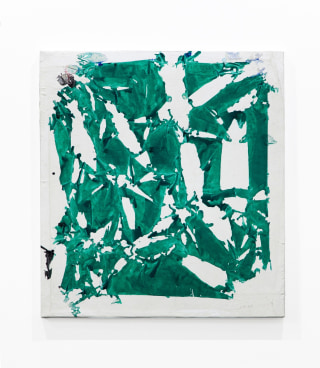Making a mark upon the world can be seen as an act of hubris or a frank recognition of the limits of unique inscription, depending upon one’s philosophical inclinations. Simon Hantaï (1922–2008) realized the latter in his painting after having disproven to himself the moral efficacy of the former. Arriving in post-war Paris from his native Hungary in 1949, at a time when the marks of man upon the world were yet freshly traced in martial scarification, he found himself displaced and grasping at the tattered hem of “The Absolute” (of essentially Catholic exegesis), among the remnants of the Surrealist circle of André Breton. He developed in this milieu from the anthropomorphic figuration of Surrealism toward the basic activity of the automatism that prefigured such. Benjamin Buchloh described the situation of HantaÏ’s response to the necessity of redefining painting in a shattered post-war France as both recovered interest in Matisse’s late cutout works (works which significantly declare the limits of the anthropomorphic gesture by the square) and his ambition: “to conceive of a new type of painting of pure—almost self-generated—design outside of an author's intentional composition; to allow for a random constellation of chroma and aleatory, yet serialized form, in order to transcend both the limitations of a Constructivist techno-scientific abstraction and those of the biomorphic and automatist design of the Surrealists of the 1920s.” His devolution from the quasi-illustrative body toward the more fundamental instantiation of the embodied gesture was largely prompted by his encounter with Jackson Pollock’s “drip” compositions of the late 1940s and early '50s. Hantaï understood Pollock’s hands off approach to painting—his stick-dangled divination of centripetal form, hovering ritualistically above the prone and unstretched canvas—as a way to reanimate automatist gesture in order to make the traditional, authorial hand disappear. If one imagines academic painting technique as a way for the artist to “cover their tracks” (their marks upon the world) with technical (prideful) mastery, in contrast Hantaï’s response to Pollock was to further expose the aleatory nature of the painterly gesture for and by itself, effectively leaving himself out of the picture. His pliage (folding) technique was an intentional act of “deskilling” that opened his work to a much more egalitarian interpretation of the crafting of form and, in terms of social analogy, a philosophy of the commons.
Simon Hantaï: Unfolding
Tom McGlynn, The Brooklyn Rail, 14 February 2024

